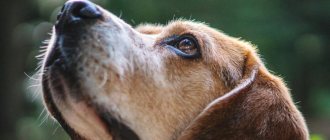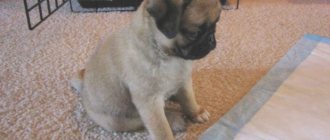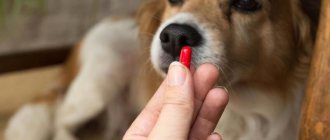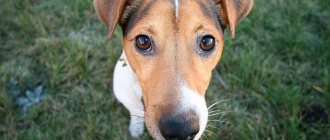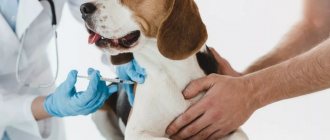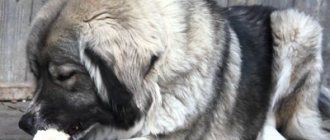How to cope with the death of your beloved dog?
Faced with inevitable grief, many owners have no idea how to cope with the death of their beloved dog. There are various techniques that help relieve acute pain, but the final recovery from loss comes only with time.
Science has established that a person experiences the death of a loved one (including a person) within 1 year. Many owners find it easier to cope with loss if another animal appears in the house.
Note! If there are children in the house, it is recommended to get a second pet in advance.
There are two opposing techniques to help cope with loss:
- Suspension.
- Living with memories until they stop hurting.
Both methods work, but their effectiveness depends on the person’s temperament.
SUDDEN DEATH IN DOGS AND CATS. HOW TO AVOID.
It happens that a seemingly healthy pet, without receiving any visible injury, dies in a matter of seconds, minutes or hours.
Pathomorphologist of the Biocontrol veterinary clinic, Candidate of Biological Sciences Dmitry Evgenievich Mitrushkin talks about the common causes of sudden death of dogs and cats. POISONING IN DOGS AND CATS.
Dogs are more often poisoned by poisons intended to control rodents (rats and mice), and poisons distributed by “dog hunters” (persons who, on their own initiative, exterminate stray dogs).
Poisons against rodents are often anticoagulants (substances that reduce blood clotting, for example, zoocoumarin), leading to massive hemorrhages in the skin and internal organs (primarily in the cavity of the stomach and intestines). They manifest themselves as lethargy, diarrhea and/or vomiting with blood and the development of severe anemia. It should be added that the death of a small dog (or cat) can occur from eating a poisoned mouse or rat (weakened and becoming easy prey because bleeding has already begun in its organs and tissues).
The poison used by “dog hunters” is often the drug isoniazid, intended for the treatment of human tuberculosis, but which is toxic to dogs. It is added in the form of tablets to sausages or sausages laid out on the ground in courtyards and parks. Sometimes domestic dogs also eat them. The effect of the drug begins after 1-1.5 hours and leads to inhibition of brain activity, resulting in confusion, incoordination of movements, followed by excessive salivation and foaming from the mouth. In case of severe poisoning, convulsions, coma, and paralysis of the respiratory muscles are possible.
To prevent the poisoning described above, it is necessary to educate the dog in the ability not to pick up food from the ground, walk it on a leash and constantly carefully watch what it is doing. If you are unable to keep an eye on your dog, you should put a fully closed muzzle on it, especially in places where you have already seen a pack of stray dogs or heard about it from other owners.
Cats are pickier eaters (compared to dogs) and are more likely to be poisoned by antifreeze (a sweet-tasting liquid that does not freeze at low temperatures, used to cool internal combustion engines) or lilies.
Antifreeze can leak under the car or be spilled by the car owner on the asphalt, garage floor, etc. When thirsty animals lick the resulting puddle (or simply lick their paws that have passed through it), ethylene glycol, which is the basis of antifreeze, is absorbed in the gastrointestinal tract. Within an hour, vomiting, weakness, and loss of coordination of movements begin with a further progressive reduction in the amount of urine (up to its absence) due to the development of acute renal failure. It should be added that the lethal dose of antifreeze for a cat may be about 1.5 ml/kg, for a dog - about 6.6 ml/kg. To prevent poisoning, it is necessary to prevent antifreeze from leaking or use antifreeze based on propylene glycol, which has lower toxicity.
Many types of lilies are toxic to cats. Eating them or pollen that ends up on the animal’s fur (with further licking and getting it into the stomach) can cause the death of the animal due to acute renal failure. Therefore, cat owners should avoid purchasing or growing this plant.
HEART DISEASE IN DOGS AND CATS
Large breeds of dogs (usually middle-aged and older) can die suddenly from a heart disease called dilated cardiomyopathy (with or without heart rhythm disturbances), characterized by dilation of the heart cavities and myocardial dysfunction. Clinically, the pathology in the early stages manifests itself asymptomatically or only with increased fatigue; As the disease develops, general weakness, rapid breathing, coughing and even fainting are usually noted.
Cats of any age often suffer from cardiac pathology such as hypertrophic cardiomyopathy. Among the most predisposed breeds are: British Shorthair, Scottish Fold, Maine Coon. The genetically determined disease is characterized by hypertrophy (thickening) of the walls of the organ (usually the left ventricle), leading to periodic rapid breathing with the mouth slightly open. The disease is complicated by either thromboembolism (acute death occurs when blood clots form in the branches of the pulmonary artery, obstructing blood flow) or pulmonary edema.
To diagnose heart disease in dogs and cats, periodic X-ray examination of the chest cavity, electrocardiography (ECG) and echocardiography (EchoCG or ultrasound of the heart) are necessary. Using these methods, a cardiologist will be able to assess the structural and functional state of the organ, prevent and treat cardiac pathologies.
PNEUMOTHORAX IN DOGS AND CATS.
Pneumothorax is the accumulation of air in the pleural cavity. It can be exogenous (usually associated with penetrating chest trauma) and endogenous origin. Endogenous pneumothorax is most often formed due to the breakthrough of air into the pleural cavity when an emphysematous bladder (thin-walled pathological cavity) or lung tumor ruptures. The occurrence of a rupture of a pathological focus of the lung is facilitated by high physical activity, a concussion of the chest, and a sharp cough impulse. The pathology, classified as a complication of the disease, is manifested by increasing respiratory failure, causing the death of the animal. To prevent pneumothorax, it is recommended to avoid physical overload and periodically conduct x-ray examinations of the chest cavity of dogs and cats.
TRACHEA COLLAPSE IN DOGS.
Tracheal collapse is a hereditary chronic disease characterized by a narrowing of the lumen of the trachea (the air tube connecting the larynx to the lungs). The disease is more common in dwarf breeds of dogs (Yorkshire terriers, toy terriers, Chihuahuas, dwarf Spitz, Pekingese, dwarf poodles, etc.) aged 6 months to 7 years.
Clinically, a sudden cough is observed, more often after physical exertion or emotional stress, moist rales, and depression of the general condition. As the disease progresses, manifested by a pronounced degree of flattening of the trachea, the animal may die from suffocation. To prevent symptoms of the disease in predisposed breeds of dogs, it is especially important to conduct an X-ray examination of the trachea, check the upper respiratory tract for chronic infection, prevent hypothermia and obesity, and replace the collar with a harness.
ATLANTO-AXIAL INSTABILITY IN DOGS.
The disease is more often observed in young dogs of dwarf breeds (Yorkshire terriers, toy terriers, Chihuahuas, etc.). Atlanto-axial instability is a congenital pathology, which is characterized by displacement of the first cervical vertebra (atlas) relative to the second (epistrophy). The main reason is underdevelopment or rupture of the ligaments connecting these two vertebrae. Trauma to this area (for example, when an animal falls from your hand) can lead to an acceleration of the onset of the main clinical signs (acute pain when moving the head, manifested by yelping); forced position of the head and neck no higher than the level of the withers; weakness of the thoracic and pelvic limbs). Possible acute development of symptoms and death from compression of the spinal cord by epistrophy.
ACUTE DILATION AND VOLSION OF THE STOMACH IN DOGS.
Acute gastric dilatation is a disease characterized by significant bloating (swelling) of the stomach due to weakness of its wall or spasm of the pylorus (the narrowed part of the stomach at the point of its transition to the duodenum). Large, less often medium-sized dogs (usually older ones) are affected. The disease leads to compression of the diaphragm, large vessels and intestines, which leads to intestinal obstruction, as well as a decrease in blood supply to many organs, leading to death.
A fatal disease of large and medium-sized dogs also includes gastric volvulus, complicated by necrosis of its wall due to torsion of blood vessels, which can occur without previous acute dilatation of the organ. The main reason is weakness and stretching of the gastric ligaments (usually in older dogs), which are unable to hold the stomach in the correct position, as well as the absence of the gastrocolic ligament in dogs (present in humans).
Clinically, with the above-described stomach diseases, anxiety turning into stiffness, increased salivation, vomiting, enlarged abdomen in the area of the last ribs, shortness of breath, bulging eyes, pallor (or cyanosis) of the gums are observed. Prevention of acute dilation and volvulus of the stomach of dogs comes down to recommendations for normalizing nutrition and physical activity:
- animals should be fed two to three times a day in small portions. The diet should reduce the amount of carbohydrates (cereals and vegetables) and increase the content of high-quality protein products (meat, fish). We recommend premium industrial dry food from world-famous companies, all of whose components are balanced. Protein food saturates in small volume and is processed by the body quickly, i.e. does not overfill the stomach and does not stretch its walls.
-feeding and walking (and even more so the working use of the animal) should be at intervals of at least one and a half to two hours; food and water should be at room temperature.
- try to keep your dog, especially older ones, in good physical shape.
STOMACH ULCERS IN DOGS AND CATS.
Gastric ulcer is a disease characterized by the formation of ulcers (local defects) in the internal layers of the organ wall. The progression of the ulcerative process can manifest itself with such deadly complications as perforation or gastric bleeding. When perforation (perforation) of the ulcer, i.e. the formation of a through hole in the gastric wall, food along with gastric juice penetrates into the peritoneal cavity with the development of acute peritonitis (characterized exclusively by acute “dagger” pain). In more rare cases, an ulcer formed over a relatively large vessel can cause bleeding into the stomach cavity (manifested by bloody vomiting and the release of black feces due to the admixture of a large amount of discolored blood). To prevent gastric ulcers, nutritious feeding of dogs and cats is recommended (see recommendations for normalizing nutrition in the previous topic).
RUPTURE OF SPLEN TUMORS IN DOGS AND CATS.
With spleen tumors (both benign, for example, hematoma, and malignant, for example, lymphoma), they can rupture with bleeding into the peritoneal cavity (with fatal blood loss). Rupture of splenic tumors can occur with the most minor trauma (including with strong straining during bowel movements, with intense physical activity), either immediately or delayed. For an intact spleen to rupture, the injury must be significant, often combined with injury to other organs. To prevent this disease, it is necessary to conduct a preventive ultrasound of the abdominal cavity of dogs and cats.
FOREIGN BODY IN THE PHARYNX IN DOGS AND CATS.
A variety of foreign bodies (pieces of toys, bones, splinters, broken glass, sewing needle) may end up in the throat of a dog or cat (usually puppies and kittens) while playing with various objects or hastily eating. The animal will lie with its mouth open; breathing will become difficult, coughing will occur with the development of suffocation. If there is a large foreign body in the throat, then instant death of the pet is possible.
To prevent the disease you should:
- before leaving for work, close all doors to the rooms, leaving the kitchen and corridor for the animal to move around; put away shoes;
-buy toys made specifically for dogs and cats that cannot be chewed into small pieces or swallowed whole (the most reliable are made of cast rubber or edible toys).
HEAT STROKE IN DOGS AND CATS
Heatstroke is a condition that occurs as a result of prolonged overheating of the body (often in dogs in a car on a hot day). Overheating is especially dangerous for dogs of short-faced (brachycephalic) breeds - bulldogs, boxers, pugs, Pekingese, as well as representatives of long-haired breeds. Animals suffering from heart or lung disease are at risk. Dogs' breathing and heart rate increase, their body temperature rises, and a coma develops. To prevent heat stroke, never leave your dog in a parked car in hot weather; Provide the animal with access to a cool room and plenty of water on a hot day.
ELECTRICAL INJURY IN DOGS AND CATS.
Electrical injury – electric shock. Death from electric shock most often occurs in puppies and kittens when they chew the wire of an electrical appliance (TV, refrigerator, etc.) that is plugged into the network. Electric current passing through the body can lead to cardiac arrest.
Cats are more resistant to electric shock. The death of an animal is also possible if it comes into contact with a bare or broken electrical wire. To reduce the risk of electrical injury, do not leave a teething puppy in a room where there are live wires.
In conclusion, it must be recalled that a responsible pet owner must know in advance exactly which veterinary clinic (at any time of the day or night) he will immediately take his pet in the event of a sharp deterioration in health, without wasting time looking for “who to turn to” for diagnostic and therapeutic measures.
What you need to prepare
What should you prepare if you know in advance that you will soon lose your dog? Psychologists recommend resorting to a standard scheme, which works in most cases, by preparing:
- Many owners feel more comfortable if the collar and their pet’s favorite toy are stored in a beautiful box. It becomes easier if you get rid of or remove the dog's equipment, bowls and other accessories that they may resemble.
- A few bright photographs of your pet, in case the melancholy becomes unbearable.
- New routes of movement - in the first few months after the death of your pet, avoid places where you walked.
- Support group – keep in touch with dog owners and their pets.
Tip: If possible, take a lot of photos and record videos of your pet in advance. After 2-3 years, they will stop causing pain and will help you remember your pet with warmth.
Many owners say that they felt better after visiting their pet’s grave. Since burying dogs in the ground is illegal in most countries, Japan has invented an alternative method - a virtual pet cemetery.
The virtual platform is somewhat reminiscent of a social network, where a separate page is created for a deceased pet. Multilingual support groups operate on such Internet sites.
What could be the reason?
Main reasons
, according to which an entire litter can die during the first three weeks of life are:
- herpes virus infection;
- infectious hepatitis;
- and less commonly, a bacterial infection that enters the baby’s body through mother’s milk.
Puppies can also be infected with pathogenic microorganisms that develop at lightning speed, followed by sudden death of the litter.
Herpes virus infection
– infection of puppies occurs through saliva and discharge from the nasal cavity. It also occurs during accidental contact, when feeding from the same bowl. An animal owner can easily cause their pets to become ill; through contact with infected dogs, the virus can be carried on clothes, hands or other objects. Rarely, the herpes virus can be transmitted through sexual contact.
As a rule, improper keeping of dogs in kennels, crowding in houses where there is at least one individual infected with a herpes virus infection, leads to almost 100% of the disease in all other animals. At the same time, in adult dogs, clinical signs rarely appear clearly; they already have good resistance to the virus, but in pregnant dogs who have never been in contact with the herpes virus and in small puppies that were born from mothers who have never had herpes, the virus is very spreads quickly throughout the body. The death of a puppy does not occur immediately, but during the first two weeks of life.
Transporting the body in a car
Quite often, even knowing that the pet will soon pass away, the owner does not have time to think through the technical details. For example, transporting a body in a car may become a problem.
If the dog is large, after death it will be very difficult to carry it. Rigor mortis occurs within 4–5 hours. If you are going to bury your dog in the ground or transport it by car, you must do the following:
- Pull your pet's paws towards the body and tie them together.
- Bend your front paws at the knees and fix them in this position.
- As a result, the posture of the deceased pet will resemble a ball.
- After the onset of rigor mortis, the ties must be removed.
Even after death, the dog may have repeated bowel and bladder movements. The luggage compartment of the car must be covered with thick film and a blanket. After you place the dog's body in the car, it needs to be covered.
Main features
The following signs will let you know that your dog is about to die. Depending on the situation, these signs will either provide a last chance for salvation, or time to prepare and say goodbye.
Activity is one of the most striking signs of fading vitality, this is a decrease in activity. Out of habit, the dog will ask to go outside, try to endure the toilet, follow the owner’s commands, and behave as usual. However, an observant owner will notice that games and walking do not bring the animal as much pleasure as before. After a walk, the dog will lie down in its place and sleep for a long time, and will not enjoy prolonged communication.
Reflexes – against the background of decreased activity, lethargy and impaired reflexes occur. At first, these violations will not be obvious, but you will notice that the pet tries not to run fast, avoids sudden maneuvers, and often lies down during walks. Even dogs that were cocky in their youth begin to give in to young animals and aggressive relatives. At this moment, it is important to support your pet and try to ensure its maximum safety and self-confidence. If you notice that your dog feels uncomfortable on a walk, consider moving the walk to a more secluded place.
Metabolic slowdown - many dog lovers say that the dog’s appetite worsens in anticipation of death, but this is not always the case. In the process of natural cell degradation and metabolic processes, the following trends can be observed:
- The dog eats well, but does not gain weight.
- The pet independently reduces the daily food intake, but drinks well.
- Despite normal fluid intake, the dog develops dehydration.
- The dog develops vitamin deficiency or a clear deficiency of nutrients.
Weight loss with a normal diet can indicate not only a metabolic disorder, but also a number of diseases:
- With a helminthic infestation, the dog will lose weight, but its appetite will only improve at first. If your pet is elderly and you suspect a helminthic infestation, you should consult your veterinarian about adequate preventive measures. Not all drugs designed to remove worms are designed to take into account the slow metabolism of older animals.
- Weight loss while eating normally may indicate systemic diseases, such as diabetes or other abnormalities in the body. Carefully monitor your pet's condition, since in old age the risk of developing diseases to which the dog is prone increases.
- Skin and coat - against the background of impaired metabolism, a dog may consume the usual amount of water and food, but suffer from a deficiency of microelements or dehydration. One of the most obvious signs of dehydration is poor skin and coat condition. The wool becomes disheveled, loses its natural shine, becomes severely deformed, and breaks. If you look closely at the skin, you may notice a large number of scales or even cracks. However, do not rush to conclusions and take your dog to the vet. This may indicate seborrhea, which most older but still physically strong dogs are prone to.
- Breathing – disruption of the respiratory system – is a clear sign that your pet is about to leave. When metabolic processes slow down critically, the dog falls into a lethargic state. You may notice a slowing in your breathing rate. Depending on the size of the dog, the normal breathing rate varies from 22 to 30 breaths per minute. When breathing slows down, the dog breathes slowly, deeply, often with an open mouth. The breathing rate usually decreases to 10–11 breaths per minute. Just before death, the dog continues to make breathing movements, but in fact it does not inhale or exhale air, since the lungs no longer expand.
- Heart Rate – After slowing down your breathing, you may notice a clear decrease in your heart rate. A healthy dog has a strong pulse with a frequency of 100-130 beats per minute. In a dog whose metabolism is slow, the heart rate drops to 50-80 beats per minute. When the pulse decreases, a natural drop in blood pressure occurs, which is accompanied by severe weakness and apathy. Usually the dog tries to hide in a dark, secluded place, hardly moves, and when trying to move from place to place, the pet sways greatly. At this stage, only the dog’s comfort depends on you; if the pet dies of old age, you can assume that this condition is irreversible. However, be prepared for the fact that the dog may remain in a state of lethargy for a day or even more. There is no need to force your pet to eat, drink, or get up.
- Digestive system - a few days, and maybe hours, before death, the dog will completely refuse food. In this case, the pet may involuntarily empty its intestines and bladder. Even if the dog does not eat anything, feces will remain in the intestines, since the peristalsis of the intestinal walls is greatly reduced. Offer water to your pet, but do not force your dog to drink. Be prepared for the fact that in the last days and hours, the pet will go to the toilet under itself. If the dog gets up and asks to go outside (and this often happens), take it out for a walk in your arms and immediately bring it home. Immediately after death, the dog will have an involuntary and complete emptying of the intestines and bladder. This happens because the muscles completely relax after the death throes.
- Mucous membranes - against the background of dehydration, metabolic disorders, and nutritional deficiency, the dog may develop oxygen starvation of cells. At first, you may not notice anything other than a change in the color of the mucous membranes of the eyelids and gums. Typically, the gums become gray, whitish, or almost transparent. Try to measure your pet's temperature; if it is low, provide the dog with warmth. When the temperature naturally drops, the dog experiences chills, and when the animal is cold, it cannot relax - this is a reflex.
About the death agony
Many owners panic when their pet is in its death throes. Fear is caused not even by the loss of a dog, but by the state in which it is interrupted before death. It is important to learn one thing, you cannot change anything, but it depends on you how your pet will feel in the last moments of its life. Keep calm with all your might, don’t cry, hug the animal, calm it down, try not to let your voice tremble.
Yes, these recommendations look cold, they are almost impossible to follow when the pet licks his hands and says goodbye. You may not believe it, but dogs have a presentiment of death, they are afraid of it just like people.
Learn one more truth, your pet devoted his whole life to serving you, he was ready to do anything to make you happy. Try to be happy in the last moments of his life, so that when he leaves, your pet knows that he coped with his task perfectly.
Let's take a break from philosophy, what is the death agony? As mentioned above, a few hours before death the dog falls into lethargy. This state can be described in different ways: indifference, complete calm, tranquility, and so on. From a scientific point of view, lethargy is a partial cessation of the functioning of brain neurons. Being in lethargy, the dog practically does not feel pain, loses its sense of smell and hearing. The last thing a dog loses is its vision and sense of touch, which is why it is so important to be close and constantly in contact with it.
When it comes to death from old age, we can say that death is painless. The pet may feel sick. Nausea in this case is natural and should not be stopped. Try to maintain eye contact with your dog until his pupils dilate and no longer respond to light.
Lack of pupil accommodation indicates complete lethargy or coma. After loss of vision, the dog only feels stroking (and not always), but at the same time the nerve endings of the skin constantly and very rapidly atrophy. No matter how hard it is for you, you need to remember that after the atrophy of the pupils, the dog no longer feels almost anything.
Burial in a pet cemetery
Burial in a pet cemetery is considered the most acceptable option for many owners. Unfortunately, pet cemeteries only exist in large cities, and the number of places is limited. In addition, as cynical as it may sound, a pet cemetery is a business whose owners ignore the consequences for the environment.
To obtain permission to bury a dog in a cemetery, you must have an autopsy report stating that the pet did not die from a viral disease. To conduct a funeral, a one-time fee is paid and a place is purchased. After the funeral, it is allowed to install a monument on the gravestone.
How to help a dying dog
To make it easier for your pet to pass away, you should observe how the dog behaves before death. A dog's behavior before death always changes, and an attentive, loving owner cannot fail to notice this. If a dog dies easily, then he needs nothing but peace and quiet, and sometimes the presence of his owner. Many dogs lick their owners' hands and wag their tails even in their last moments of life.
If dying is associated with the dog’s physical suffering, then the owner’s duty is to alleviate his condition and decide on euthanasia or consider all options for a worthy farewell to his final journey. This is not murder, as many people think, but the last help to someone who has been around for many years and who helped cope with everyday difficulties as best he could.
Euthanasia is necessary for animals dying from cancer, due to multiple injuries, severe head trauma, multiple bleeding, or an incurable infectious disease. Only a veterinarian can perform this.
Dog cremation
By international standards, dog cremation is the only correct and legal burial method.
Note! By law, it is prohibited to scatter the ashes of animals and people. This ban exists all over the world, but is often ignored.
In most cities, cremation is carried out at utility companies that have the appropriate equipment. The problem is that most crematoriums are designed to burn a lot of weight, so if you want to take the dog's ashes, the funeral will cost a significant amount.
Specialized crematoriums for individual burial are very rare, but they exist. Usually, on the basis of the crematorium, there is a columbarium where the ashes of the dog can be stored.
Right
Died - used in relation to a person, means to cease to live, to cease to exist. Can also be used in relation to animals to which a person has an emotional attachment (pets). He died a month short of his centenary. Ivanov died yesterday at eight in the evening. Barsik, unfortunately, died of old age. My parrot died this morning.
Died - used in relation to animals, means the same as “died”. It also has a derogatory meaning when used in relation to a person. Stepanovich's cow died, we need to help him. The yard dog died, but no one noticed. It's better to die than to live with such a stingy fellow! Make sure he doesn't die of thirst, we need prisoners
Popular superstitions serve as a hint and a warning. Even negative events predict the near future. If a dog died, the signs directly depend on the time of day or day when the animal died. The cause of his death is also important. But the negative meaning of superstition in any event cannot be perceived as an inviolable truth.
Funerals in non-specialized places
Funerals in non-specialized places are illegal. Such actions are regarded as a violation of the criminal code and can be interpreted as hooliganism, causing intentional harm, etc.
If your city does not have a pet cemetery or crematorium, then you have no alternatives. To avoid problems with the law, do not bury your dog within the city limits and do not erect a monument.
Burial outside a non-residential area reduces the risk of infecting other animals if your dog dies from the virus. However, when burying a pet in forest belts, you need to take into account that the grave can be found and dug up by wild animals. To prevent desecration of the grave, it is better to lay several large stones or a metal mesh on top of the loose earth.
If the cat died...
In most cases, old cats try to move away from home when they feel that their hour of death has come. They thereby take with them the remnants of negative energy from the home. They try to leave it cozy. When a cat dies, signs can be interpreted in different ways. It is important to remember the circumstances of your pet’s death and, based on them, predict your future.
Circumstances of pet's death and interpretation
The circumstances of death may vary:
- If the cat left and did not return (died quietly), then despite the tragedy of the situation, this is a good sign that promises you a promotion at work or a reward. If the color of her coat was white, then the sign indicates the onset of stability in family life. Fishermen should refrain from going fishing for several days; there will be no catch or you will be in trouble on the water.
- In most city apartments, cats do not have the opportunity to leave the house to die quietly. Therefore, it is worth remembering the sign that the death of a pet in your home portends trouble. Try to let the old or sick animal go, of course, it is very difficult to do this, but the pet is trying for your sake.
- If you suddenly find a dead cat in your house, then you should postpone your business for another time, luck is temporarily not with you. You cannot kill an animal that has been suffering or throw it away - otherwise you should not expect 7 years of happiness.
- A dead cat on your doorstep is a harbinger of health problems; the disease can be very serious. It could also be a sign of an enemy who wants to greatly harm you. Do not be afraid that a dark sorcerer or a hater will bury a dead cat near your house - this ritual is based on simple self-hypnosis, it will not work.
- If you meet a black dead cat on the road, the sign says that you will soon experience financial well-being.
If a cat died suddenly and at a fairly young age, then this may be a sign of severe damage or the evil eye. The animal has become your shield against negative energy, partially taking it upon itself. You may encounter troubles or sudden illness. Signs are given a similar interpretation if cats are constantly dying in your house and you cannot get a new pet.
How to eliminate negativity
It is important to properly guide your pet into the other world so that bad things don’t happen to you:
- find a quiet and peaceful place, bury the body there;
- come home, wash your face and wash your hands;
- perform a ritual to get rid of negative energy in the house.
The simplest ritual for cleansing a home includes: spraying all corners with holy water, walking through the rooms with a lit church candle. After you have cleansed the entire house with the flame of a candle, leave it in the room where it was especially fuming. Do not put out the flame until it burns out on its own.
Features of funerals in the winter season
Great difficulties await owners who lose their pets during the frosty winter period. If there is a crematorium in the city, it is wiser to pay and avoid additional problems. Burial in a pet cemetery during the winter is also possible, but costs more.
Features of funerals in the winter season:
- Frozen ground is very difficult to dig, so immediately after death, the pet’s body must be fixed as described above.
- If there is a human crematorium in your city, it is worth asking if they offer cremation services for animals. Practice shows that such services are provided unofficially.
If there are ritual services in the city that bury animals, you can contact them. Find out in advance about the location and method of burial. Quite often, in pursuit of profit, the corpses of dogs are simply burned or thrown out outside the city.
How to recognize a dog's approaching old age?
Dogs show the same signs of aging as humans. Gray hair appears in their fur, their eyes become dull, they eat less and less eagerly, they move more slowly, during walks they show little interest in the world around them, preferring to return home soon, they hardly or at all do not play and increasingly prefer to lie down in silence and away from others. dogs and from people. This condition can last from several months to a year if the dog is not suffering from the disease. He quietly fades away and becomes weaker and weaker until his time finally comes to leave his family.
In older animals, the hair sheds and is not restored, and bald patches may form on the elbows, the area around the tail and on the stomach. Teeth may fall out, at least they are no longer sharp, but very worn down and darkened.
An old dog or one exhausted by a chronic illness will breathe intermittently and wheeze, its hair will fall out and its nails will peel off, its nose will be mostly dry, its gait will be unsteady due to falling glucose levels, its urine will become dark in color, and its stool will often be loose for no apparent reason. The dog still reacts positively to affection, but does not actively ask for attention. More and more often he simply dozes in solitude. He may be irritated by loud noises, bright lights, and strangers. An aging animal, like an old person, needs peace, quiet, moderate temperature, dim lighting, a light diet and respect for personal space.
A sign of old age is a weakening of the sexual instinct. An elderly male does not care that a female dog is in heat nearby, he does not perform a courtship ritual and does not enter into competition with other males, and an old female dog who is in heat drives away male dogs and is not allowed to mount them on herself.
If an animal sleeps poorly, whines, moans, shows anxiety or aggression, most likely it is in pain. This is especially likely for dogs with tumor diseases, diseases of the kidneys, liver, digestive organs, and joint diseases. Pain syndrome is also observed in animals after injuries and surgical operations. In this case, you should contact your veterinarian to prescribe a pain reliever to alleviate the dog’s condition.
Many veterinary clinics offer hospital services with medical care for dying animals. But if the owner has even the slightest opportunity to leave the dog at home and give painkilling injections on his own, then it is better to give the dog the opportunity to die where he lived, next to his owner and his family. This is difficult for the owner, but more comfortable and honest from the dog’s point of view.
Dream about a dead animal
A separate type of signs concerns dreams. The dog owner sees a living dog or a dead dog - both animals warn of imminent events that affect a person’s life. The death of a non-existent pet in a dream is the loss of a friend in real life. A reliable partner or colleague will show his true colors. Intrigues and betrayal will be revealed.
If a real pet dies in a dream, in real life a person will face difficulties in communicating with people. He will get a new position or move to another job, but will not be able to adapt quickly. He will face misunderstanding and even alienation from the people around him.
The death of a pet in a dream and in real life is a serious warning. The pet is trying to warn about illness or a long period of stagnation. The more a person ignores the signs of fate, the more difficult it will be to accept the essence of the problem. A real danger is approaching the house.
If a dead pet is aggressive in a dream, trouble will come from outside from strangers. A dead pet is affectionate in a dream - problems are created independently: by false attitudes or incorrect behavior.
How to remove the negative meaning of a sign
The death of a pet is an unfortunate event, but it is not a reason for reckless behavior. Negative signs are neutralized by the correct actions of the dog owner.
According to popular belief, you should not bury your pet near your home. Such an act will affect the financial well-being of the family. There will be constant troubles in the house.
- Caring for a sick animal. An act such as killing a pet, even if it is in pain, will turn against a person. To kill a dog is to call the trouble upon yourself. It will be worse than any damage. If you refuse to help a dying dog, expect deception and betrayal. The best option for a dog owner is to stay close to the dying pet or go to a veterinary clinic to have it painlessly euthanized.
- Funeral of a pet. Since ancient times, danger came to the house if, after the death of a dog, its body was burned at the stake. The correct burial of a dog is to bury it under a tree or in the garden. To avoid causing trouble, you should not bury your pet at night or after sunset.
If a dog barks before dying, you should not open windows and doors in the house so as not to let trouble in. Helping your pet is the best protection against harm. You should not leave your dog without water or food until the last minute. It is necessary to say goodbye to a dead dog: it is better for household members to thank the pet for its faithful service and devotion.
Today Nastya and I were going to visit a friend who used to have a rat.
Nastya, naturally, is looking forward to meeting the cute rodent.
I warn her: “The rat is gone. She died"
Nastya: “Ahh. Did she die, or what?”
I laughed and asked what the difference was between “die” and “die.”
The difference is more than significant and not far from the truth:
It turned out that the dead are buried in the cemetery, and the dead are buried like this. thrown away. Or they hide the thread somewhere so as not to stumble
Well, she still got the nuance right)




